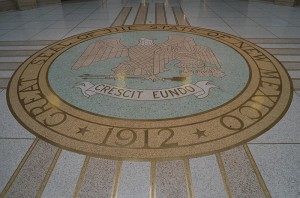Welcome to a rare instance when this column has nothing to do with engineering or philosophy!
Ever since I spent several days in New Mexico with my family during a vacation last summer, I feel like the abundant sunshine and thin, dry air have put me under some kind of spell. I find myself eager to return as soon as possible and seriously considering the prospect of retiring there someday. In the meantime, I have read nearly a dozen books – travel guides, geography and biology, customs and culture, history, and even (unusual for me) fiction – all in an effort not only to acquire information, but also to gain an intangible sense of the place.
For example, New Mexico’s flag is one of the simplest and most distinctive of the fifty states, with a red symbol centered on a yellow field. Reflecting the region’s unique history and ethnic makeup, the colors are those of old Spain, while the symbol comes from the Native American people of Zia Pueblo. Dr. Harry P. Mera, a physician and anthropologist who lived in Santa Fe, created the contest-winning design, which the legislature officially adopted in 1925. He was familiar with the symbol from its frequent appearance on clay pottery fashioned by the Zia Pueblo residents.
The symbol itself is rich in meaning, primarily representing the sun as the “Giver of all Good Gifts.” The official salute to the state flag further associates it with “perfect friendship among united cultures.” However, its significance is much deeper for the Zia people. Four is their sacred number, and the symbol includes four groups of four rays, which correspond to the four principal directions – north, south, east, and west; the four seasons of the year – spring, summer, autumn, and winter; the four phases of the day – morning, noon, evening, and night; and the four stages of life – childhood, youth, adulthood, and old age.
The symbol thus encompasses all of space and time with their ongoing cycles, including human existence, joined together by a circle of love that has no beginning or end. It also invokes four specific obligations that the Zia people recognize: a strong body, a clear mind, a pure spirit, and a devotion to the welfare of one’s people. Alternatively, Christians may perceive it as a form of cross, and the obligations in reverse order are reminiscent of the commandment to love the Lord your God with all your heart, with all your soul, with all your mind, and with all your strength.
Of course, spreading Christianity to Native Americans was one of the professed motivations for the arrival of the Spanish in New Mexico, which predates the efforts by the English along the Atlantic coast that are far more prominent in American textbooks. In fact, the name of the territory is considerably older than that of the country to our south, which was known as New Spain until its independence in 1821. Previously, “Mexico” referred primarily to the fabulous capital city of the Aztecs, conquered three hundred years earlier. Explorers were hoping to find similar riches to the north – i.e., a new Mexico. Although nothing so spectacular ever materialized, the name stuck, and the state’s official seal is delightfully clear in its symbolism – it depicts an American bald eagle taking a Mexican golden eagle under its wing.
Juan de Oñate led the first group of European settlers up the Rio Grande – then known as Rio del Norte, or River of the North – in 1598, nine years before Jamestown. The positive and negative aspects of this event are meticulously described in an epic poem written by one of Oñate’s subordinate officers, Gaspar de Villagrá, and published in Spain in 1610 as La Historia de la Nueva Mexico. That same year, Governor Pedro de Peralta founded the city of Santa Fe – a decade before the Pilgrims arrived at Plymouth Rock, making it the oldest capital in the United States. It is also the highest, at an elevation of 7,260 feet above sea level.
Visiting state capitol buildings was actually the main objective that brought us to New Mexico in the first place. We have been on a quest to see all fifty of them since my son was six and my daughter was barely a year old – they are fourteen and nine now – and this was state capitol number thirty-eight. Santa Fe is home to the nation’s oldest continuously occupied public building, the Palace of the Governors (1610), and one of its newest state capitols (1966), which residents affectionately call “the Roundhouse” since it is the only such facility in the country with a primarily circular shape. I was impressed with the apparent efficiency of its unique layout, as well as its distinctive Territorial architecture, which is the only style permitted by law in the historic portion of the city other than the even more traditional adobe look of Pueblo Revival.
Needless to say, New Mexico has made an indelible impact on me. Time will tell if its magic induces multiple future visits and ultimately draws me to make the Land of Enchantment my home.▪

